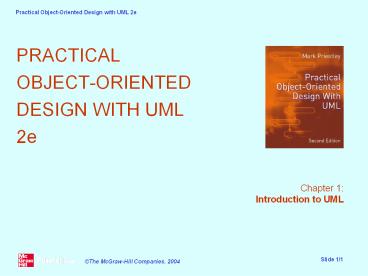PRACTICAL - PowerPoint PPT Presentation
1 / 13
Title:
PRACTICAL
Description:
Many process models have been produced describing recommended processes ... Model element. A modelling 'atom': e.g. a class or a method call. Diagram ... – PowerPoint PPT presentation
Number of Views:14
Avg rating:3.0/5.0
Title: PRACTICAL
1
- PRACTICAL
- OBJECT-ORIENTED
- DESIGN WITH UML
- 2e
Chapter 1 Introduction to UML
2
Software Development
- Many software projects end in failure - why?
- A poor software development process is one
possible cause of project failure - Many process models have been produced describing
recommended processes - Typical process models define
- An ordered set of development activities
- The deliverables of the process
3
A Simple Process Model
- In the simplest cases, code is written direct
from some statement of requirements
4
A More Complex Process
- On larger projects, intermediate pieces of
documentation are produced
5
Models
- Documents like structure charts are known as
models - They give an abstract view of the system's
structure - This makes it easier to understand
- Many different types of model in use, eg
- Flowcharts
- Dataflow diagrams
6
Analysis and Design
- Models can be used to
- Describe the structure of a real-world
application (analysis) - Describe the structure of a proposed software
system (design) - Object-oriented methods use the same notation for
both purposes - Older structured methods used different analysis
and design notations
7
Methodology
- A term (mis)used to mean a strategy for
successfully developing software - Methodologies offer two forms of guidance
- What process to follow
- What notation to use
- Different classes of methodology are in use
- Structured methods
- Object-oriented methods
8
UML Unified Modelling Language
- UML is a notation suitable for use with
object-oriented methods - UML does not define a process
- It evolved from three earlier methods
- Grady Booch's method
- OMT James Rumbaugh et al
- Objectory Ivar Jacobson
- Now the industry-standard design notation
9
'41 View Model'
- UML can describe a system from a number of
perspectives, or views - Views highlight aspects of the system important
to different stakeholders
10
Views
- Use case view describes behaviour
- Useful for analysts, users and testers
- Design view describes logical structure
- Useful for programmers as basis for coding
- Implementation view describes components
- Useful for configuration management etc
- Process and deployment views
- Describe concurrency and distribution
11
Some UML Terminology
- Model
- Sometimes, the information in a view
- Sometimes, all the information about the system
- Model element
- A modelling 'atom' e.g. a class or a method call
- Diagram
- A graphical presentation of a collection of model
elements
12
Design models and code
- UML is based on the same object model as
object-oriented programming languages
13
UML Pragmatics
- A UML model is like an abstract program
- UML can describe the structure of source code
- UML can describe the run-time behaviour
- UML is not (normally) executable
- Tools exist to support moving between UML and
code - UML should be used in conjunction with a suitable
software development process































